How to Scale Your Software Team in 2 Weeks: A Real Nearshore Staff Augmentation Blueprint
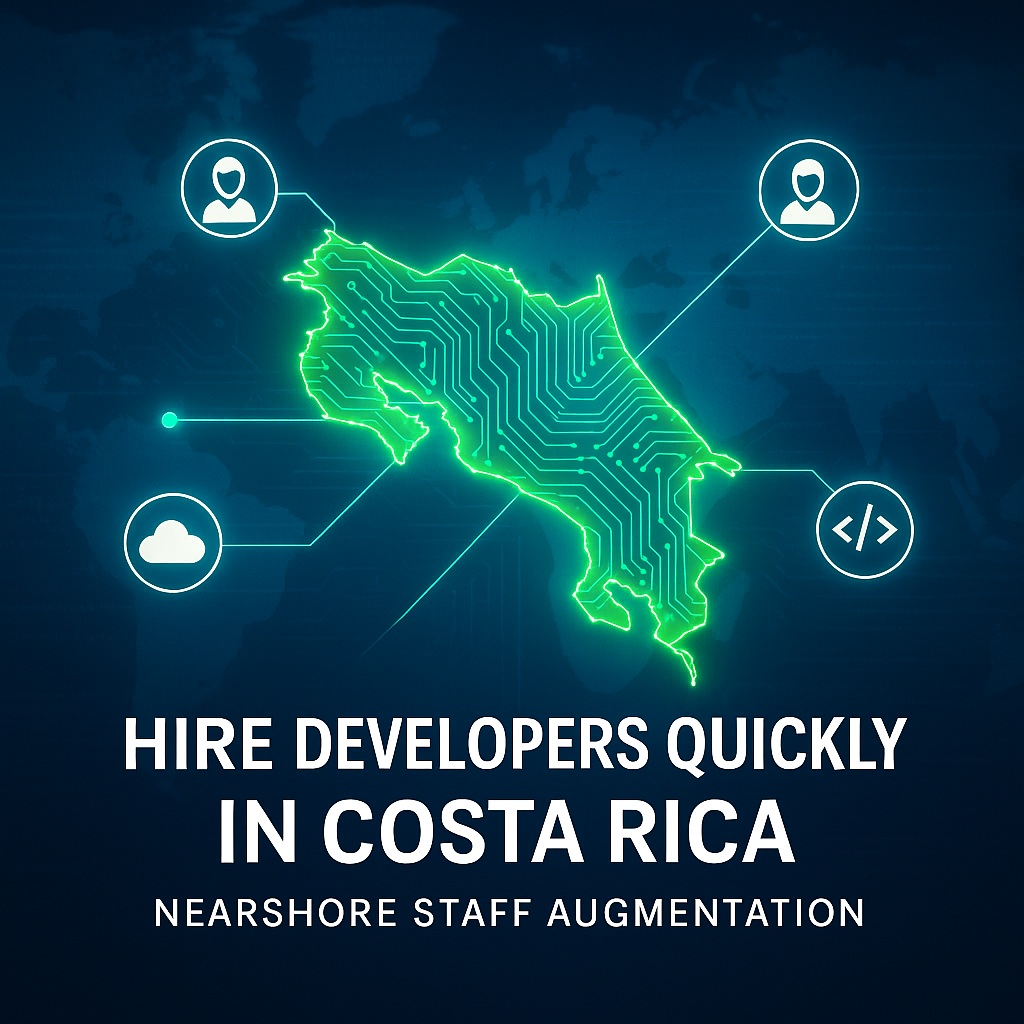
1. Introduction: The Race to Scale
When software projects grow faster than your team, every week matters.
New features, client requests, and deadlines don’t wait for traditional hiring cycles. Yet building a solid engineering team the usual way can take months, especially when you need people who are technically strong, bilingual, and culturally aligned.
That’s the challenge many U.S. companies face today, and why more of them are turning to nearshore staff augmentation in Costa Rica.
In recent years, Costa Rica has quietly become one of Latin America’s most reliable sources of engineering talent. The country offers a stable economy, strong English proficiency, and developers who work in the same time zone as most U.S. teams.
In this guide, we’ll break down a proven blueprint that allows companies to hire developers quickly in Costa Rica and get a fully operational software team in just two weeks.
This isn’t a theory. It’s a process that Near Coding has used successfully to help U.S. partners scale development teams without losing control, quality, or time.
2. The 2-Week Challenge
Every growing software company eventually reaches a breaking point.
The roadmap is clear, the funding is ready, but there aren’t enough hands on the keyboard to deliver.
Recruiting locally feels endless: posting jobs, reviewing resumes, coordinating interviews, waiting for notice periods. By the time a candidate joins, priorities have already changed.
That’s the moment when companies realize they don’t just need more developers but they need developers NOW.
This is where nearshore staff augmentation changes the equation.
Instead of spending months building a team, companies can tap into Costa Rica’s pre-vetted talent pool and form a complete development squad in as little as two weeks.
It’s not about cutting corners; it’s about removing the bottlenecks.
With a strong network of bilingual engineers, agile onboarding processes, and aligned working hours, Costa Rica allows U.S. companies to integrate developers almost as if they were sitting in the same office.
Traditional hiring looks like this:
6–12 weeks to post, screen, and interview candidates
2–4 weeks for notice periods and onboarding
Often 3 months before the first sprint starts
With a nearshore approach, the same outcome can happen in a fraction of the time.
Traditional Hiring vs. Nearshore Staff Augmentation
Here’s a simple visual that will help you see the difference instantly:
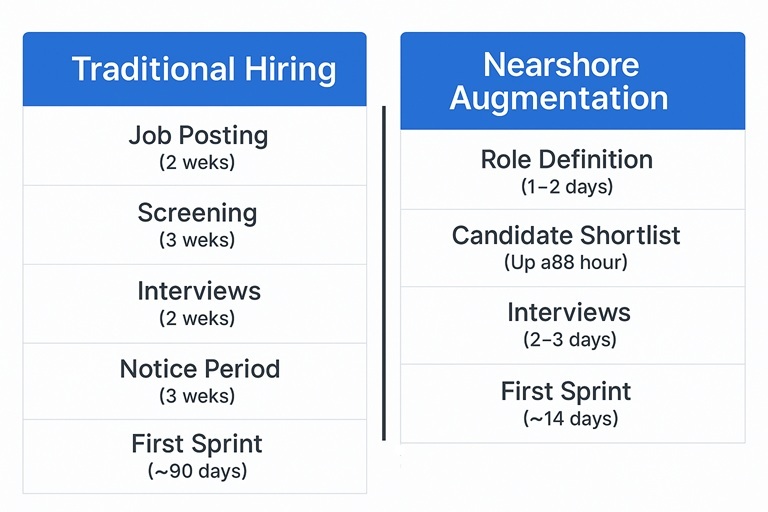
The speed difference is not the only advantage — it’s the ability to stay agile and maintain momentum when business needs shift.
3. Why Costa Rica? The Strategic Nearshore Hub
Costa Rica has become one of Latin America’s most stable and advanced technology ecosystems, and one of the most attractive destinations for companies seeking to scale software teams quickly and reliably.
What makes it stand out isn’t just its location. It’s the combination of geographical proximity, bilingual talent, political stability, and a mature business culture that aligns naturally with North American operations.
A Proven Nearshore Destination
Over the past decade, Costa Rica has consistently ranked among the top technology exporters in the region.
According to Procomer (Costa Rica’s Export Promotion Agency), the country exports over $6 billion annually in knowledge-intensive services, including software development, cybersecurity, and cloud solutions.
Global companies such as Intel, Amazon, HP, IBM, VMware, and Akamai operate large development and service centers in San José, evidence of both infrastructure readiness and talent quality.
Strategic Location and Time Zone
Costa Rica operates in Central Standard Time (GMT-6), the same as major U.S. hubs like Chicago, Dallas, and Austin for most of the year.
This alignment eliminates the friction of asynchronous communication common in offshore models. Daily standups, sprint planning, and client reviews can happen in real time without adjusting schedules.
For distributed Agile teams, this is not a small detail, it’s what allows true collaboration instead of delayed feedback loops.
Bilingual and Highly Educated Workforce
The EF English Proficiency Index 2024 ranks Costa Rica as #2 in Latin America and within the top 35 worldwide, ahead of countries like Mexico, Brazil, and Colombia.
This high English proficiency translates directly into smoother collaboration, fewer misunderstandings, and faster onboarding.
Costa Rica’s education system also produces a steady stream of qualified professionals.
Over 80% of Costa Rican developers have tertiary education in computer science or related fields (World Bank data).
Universities such as TEC (Instituto Tecnológico de Costa Rica) and University of Costa Rica (UCR) consistently rank among Latin America’s top technical institutions.
The country graduates over 4,000 engineers per year, ensuring a strong pipeline of talent for both local and international projects.
Political and Economic Stability
Costa Rica is known for being one of the most politically stable democracies in the Western Hemisphere, with no standing army since 1949.
It maintains a 98% renewable energy matrix, strong data protection laws aligned with GDPR, and is consistently ranked among the top 3 happiest countries in the world by the World Happiness Report.
For U.S. and European companies, this translates into a safe, transparent, and business-friendly environment to establish long-term nearshore partnerships.
The Result: A True Nearshore Advantage
When you combine:
Proximity and time-zone alignment
Bilingual communication
Technical depth and education
Political and economic reliability
… you get a nearshore model that doesn’t just work, it integrates seamlessly.
That’s why companies looking to hire developers quickly in Costa Rica can do so without sacrificing quality, security, or cultural alignment.
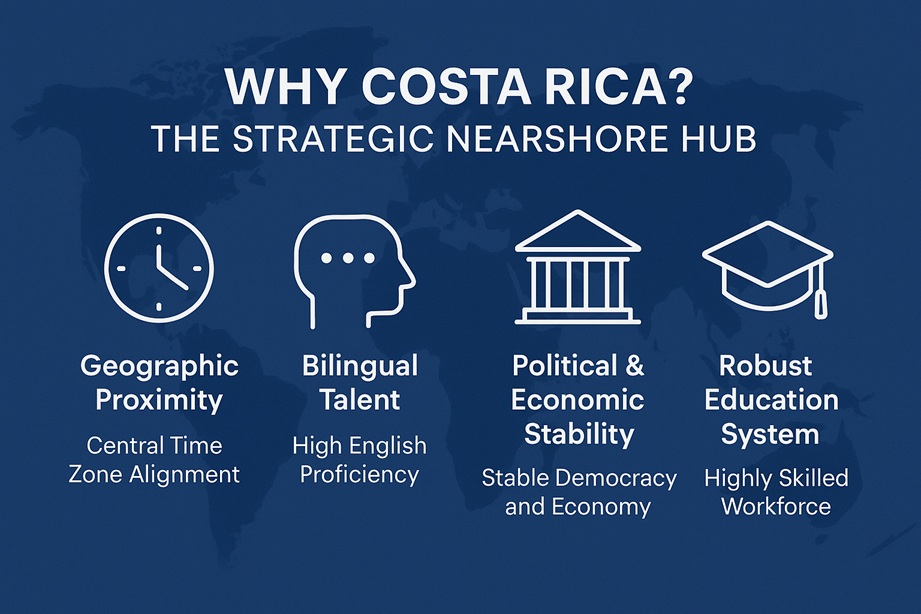
Why Costa Rica Works for Nearshore Staff Augmentation
4. The Staff Augmentation Blueprint (Step-by-Step)
Scaling a software team in just two weeks may sound ambitious, but with a structured process and the right nearshore partner, it’s entirely achievable.
The key is preparation, a pre-vetted talent pool, and a seamless onboarding framework that connects new engineers with your existing workflow from day one.
At Near Coding, this process follows a two-week operational blueprint designed to minimize delays and ensure technical and cultural alignment.
Week 1: Discovery and Selection
1. Role Definition and Technical Alignment (Days 1–2)
The process begins with a technical discovery session to clearly define each role, required skills, seniority level, project goals, and integration points.
This eliminates ambiguity and helps target candidates who can start delivering results quickly.
Fact: According to the Society for Human Resource Management (SHRM), misaligned job definitions are the #1 cause of hiring delays, adding an average of 3–4 weeks to the recruitment cycle.
2. Candidate Shortlisting (Within 48 Hours)
Using a pre-qualified network of developers in Costa Rica, we present a shortlist of candidates who match the technical and communication profile within two business days.
Each candidate is already vetted for English proficiency, background checks, and previous client performance.
3. Interviews and Technical Evaluation (Days 3–5)
Interviews are scheduled immediately and conducted jointly with the client team when possible.
Candidates undergo technical testing and cultural-fit interviews to ensure smooth collaboration from day one.
This step typically takes 2–3 days to complete.
Week 2: Integration and Kickoff
4. Offer, Documentation, and Onboarding (Days 6–8)
Once selections are made, contracts, NDAs, and access credentials are finalized.
Developers are introduced to the client’s tools (GitHub, Slack, Azure DevOps, Jira, etc.) and briefed on architecture, coding standards, and sprint cadence.
Note: This streamlined onboarding approach reduces the average “first-commit” time from 3 weeks to less than 5 days.
5. Agile Setup and Cultural Alignment (Days 9–10)
Before the first sprint, a joint kickoff call establishes expectations, communication protocols, and escalation paths.
Teams are aligned on product vision, agile ceremonies, and immediate priorities.
6. First Sprint Launch (Days 11–14)
By the end of the second week, the extended team is fully operational.
Developers participate in daily standups, take ownership of deliverables, and integrate directly into the client’s repositories and workflows.
The 2-Week Scaling Blueprint Flowchart
Below is a clear visual summary of the entire process:
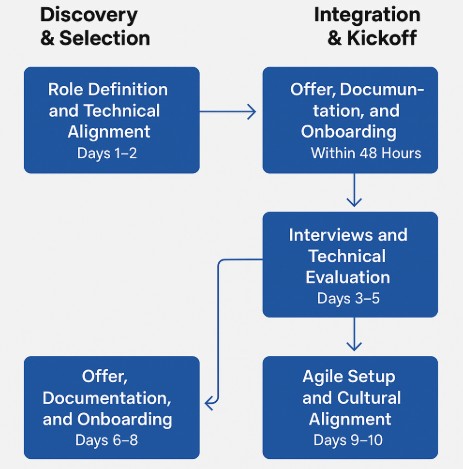
This method is built on repeatable processes, not shortcuts.
Each step is optimized to reduce idle time, eliminate redundancy, and maintain quality at scale.
It’s what allows companies partnering with Costa Rican teams to move from planning to delivery in a matter of days, not months.
5. Real Example: How a U.S. Client Scaled in 14 Days
When one of our U.S.-based partners, a technology consulting firm serving clients in the legal and telecommunications sectors, needed to expand its development capacity, they faced a familiar challenge: time.
Their internal team was managing multiple enterprise products but lacked the bandwidth to accelerate delivery for two new projects. Recruiting locally in the U.S. would take months, and missing those deadlines would cost far more than the hiring delay itself.
That’s when they turned to Near Coding for a rapid nearshore expansion strategy.
The Challenge
Build a fully functional team in less than three weeks
Ensure seamless integration with their existing U.S. Agile workflow
Maintain quality standards and data security equivalent to local hires
Avoid increasing fixed payroll costs or long-term commitments
Traditional hiring models estimated a 10–12 week timeframe and an average onboarding cost of $18,000 per employee, including recruiting, HR processing, and setup.
The Near Coding Solution
Using our 2-Week Scaling Blueprint, we assembled and onboarded a dedicated nearshore team in 14 calendar days, including:
3 Senior .NET Developers
1 QA Automation Engineer
1 Scrum Master
All team members were bilingual professionals with proven experience in enterprise-grade systems and cross-border collaboration.
From the moment the client defined the roles, Near Coding initiated the end-to-end process — from candidate vetting and interviews to technical integration and first sprint setup.
The Outcome
Within the first month:
The team delivered their first production-ready modules, reducing the client’s initial project delay by 6 weeks.
Operational costs were reduced by 35% compared to equivalent U.S.-based hires.
Daily standups and sprint reviews occurred in real time, eliminating the lag common in offshore setups.
The U.S. client’s internal developers could focus on architecture and R&D while the Near Coding team handled feature development and QA cycles.
By the end of the third month, the blended team’s velocity had increased by 42%, and both projects were back on schedule, with no compromise in quality or communication.
Why It Worked
Proven Process: Our blueprint cut the hiring cycle from 10 weeks to 2.
Cost Efficiency: The client saved approximately $60,000 in recruitment and overhead costs during the first quarter.
Cultural Alignment: Shared time zones and fluent English removed communication barriers.
Sustained Partnership: The team continues to support multiple client projects, evolving into a long-term collaboration model.
This case demonstrates how nearshore staff augmentation in Costa Rica can deliver immediate, measurable results — not just faster hiring, but faster business outcomes.
When executed with the right partner, nearshore scaling becomes less about outsourcing and more about strategic acceleration.
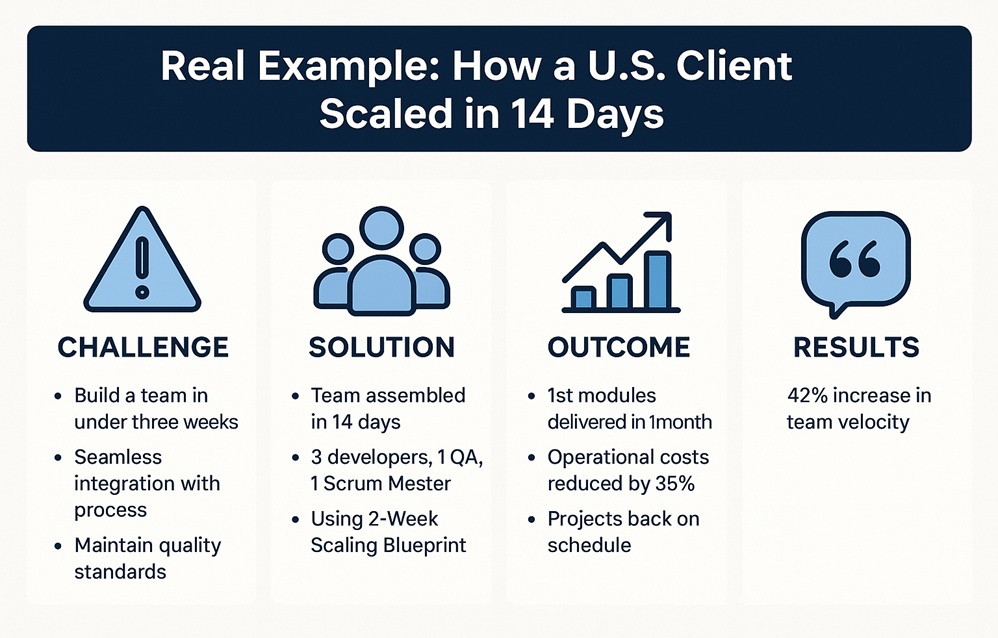
Challenge → Solution → Outcome → Results
6. What Makes This Blueprint Work
Successful nearshore scaling doesn’t happen by chance. It works because each part of the process: from talent sourcing to team integration, is built on proven operational principles that optimize both speed and quality.
At Near Coding, our 2-Week Scaling Blueprint is more than a fast hiring process. It’s a complete delivery framework backed by a continuous recruitment pipeline, bilingual collaboration culture, and agile onboarding structure that guarantees efficiency from the first day.
1. Pre-Vetted, Bilingual Developers
Every engineer in our network is pre-assessed for:
Technical depth: proficiency in frameworks such as .NET, Java, Angular, Python, React, and cloud platforms (AWS, Azure, GCP).
English fluency: validated through structured interviews and client-facing simulations.
Cultural fit: ability to collaborate directly with U.S. product owners and distributed teams.
This means our clients never start from scratch, they start from a ready pool of qualified, bilingual professionals.
Stat: On average, Near Coding shortlists candidates 3x faster than traditional recruitment agencies by maintaining a continuously updated local talent database.
2. Continuous Recruitment Pipeline
Rather than waiting for new requests to start searching, Near Coding keeps an active bench of vetted developers across multiple roles and technologies.
This reduces candidate sourcing time from several weeks to less than 48 hours for most positions.
This proactive model allows companies to scale their software teams dynamically, without pausing development or waiting for backlogged recruitment cycles.
3. Agile Onboarding and DevOps Integration
Each developer joins the client’s environment through an Agile onboarding framework that prioritizes:
Immediate access to repositories, environments, and documentation.
Integration with the client’s communication tools (Slack, Teams, Jira, Azure DevOps).
Alignment with sprint cadences and engineering standards.
This approach reduces onboarding friction and enables meaningful contribution within the first week of engagement.
Data point: Teams onboarded through Near Coding’s process report an average time-to-first-commit of 5 days, compared to 3–4 weeks in traditional setups.
4. DevOps and Quality Assurance Readiness
All Near Coding teams are equipped with standard CI/CD practices, version control protocols, and QA automation readiness.
This consistency ensures that developers, QAs, and DevOps professionals can plug directly into existing pipelines without additional overhead or training.
The result is a smooth transition from recruitment to production, keeping code quality, security, and velocity aligned with enterprise standards.
5. Cultural Alignment and Shared Ownership
Costa Rican developers thrive in environments where collaboration and accountability matter.
With cultural proximity and overlapping time zones, teams participate in real-time decisions, retrospectives, and sprint planning, not as outsourced resources, but as integrated team members.
This shared sense of ownership is what turns a hired resource into a long-term partner.
The Near Coding Success Pyramid
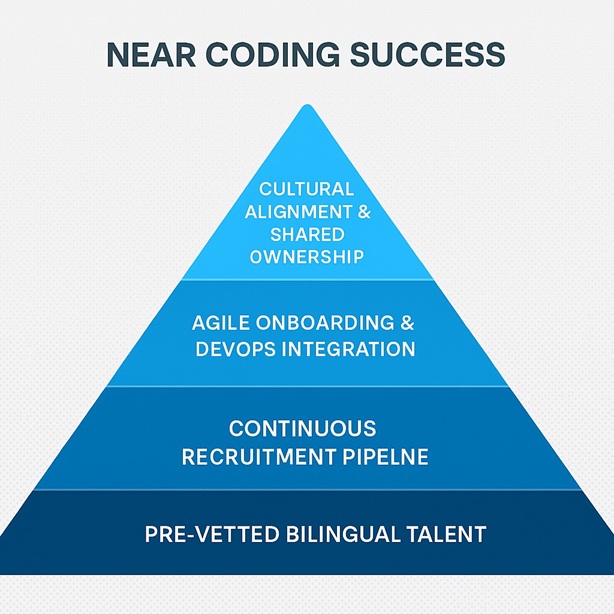
7. When to Use Staff Augmentation
Not every situation calls for staff augmentation. But when applied strategically, it becomes one of the most effective ways to accelerate product delivery, control costs, and maintain flexibility in uncertain markets.
Companies that succeed with nearshore augmentation are not simply “filling seats”, they’re using it as a scaling strategy to extend their capabilities without losing technical or cultural control.
1. Rapid Product Scaling
When your roadmap suddenly expands, new features, integrations, or customer demands, nearshore staff augmentation allows you to expand development capacity almost immediately.
Instead of pausing momentum, you can add pre-vetted developers in days while keeping your internal leads focused on architecture and long-term priorities.
Example: A fintech client expanded its QA team from 2 to 6 engineers in under two weeks through Near Coding’s network, avoiding a 45-day recruiting delay and accelerating release testing by 30%.
2. Filling Specialized Skill Gaps
Some projects require highly specific expertise, like .NET modernization, cloud migration, or test automation.
Rather than recruiting full-time specialists for temporary needs, augmentation lets you bring in senior talent only when and where you need it.
This approach not only shortens delivery time but also avoids the hidden cost of idle specialized staff once the project ends.
3. Launching MVPs or Pilot Projects
For early-stage initiatives or product prototypes, time-to-market is everything.
Through nearshore augmentation, you can assemble a complete MVP team (frontend, backend, QA, Scrum Master) in a matter of days, test your idea in production, and iterate quickly.
Once validated, you can scale the same team into a full delivery unit without restarting the recruitment process.
4. Maintaining Velocity Without Increasing Fixed Costs
Traditional hiring increases payroll, HR obligations, and long-term overhead.
Augmentation provides elastic scalability, the ability to expand or contract your team depending on project workload and business priorities.
This flexibility is particularly valuable in multi-project organizations where demand fluctuates across the year.
Fact: According to Deloitte’s Global Outsourcing Survey (2024), over 57% of technology leaders use staff augmentation specifically to manage demand peaks while maintaining predictable operational costs.
5. Building Hybrid or Distributed Teams
Modern engineering organizations increasingly use a hybrid staffing model, combining in-house leads with nearshore developers for continuous delivery.
With Costa Rica’s time zone alignment, teams collaborate in real time, maintaining the same Agile rhythm as if they were co-located.
This model helps companies grow faster, keep quality consistent, and retain full visibility over progress and performance.
Build vs. Augment Decision Matrix
Here’s a diagram that summarizes when each approach makes sense:
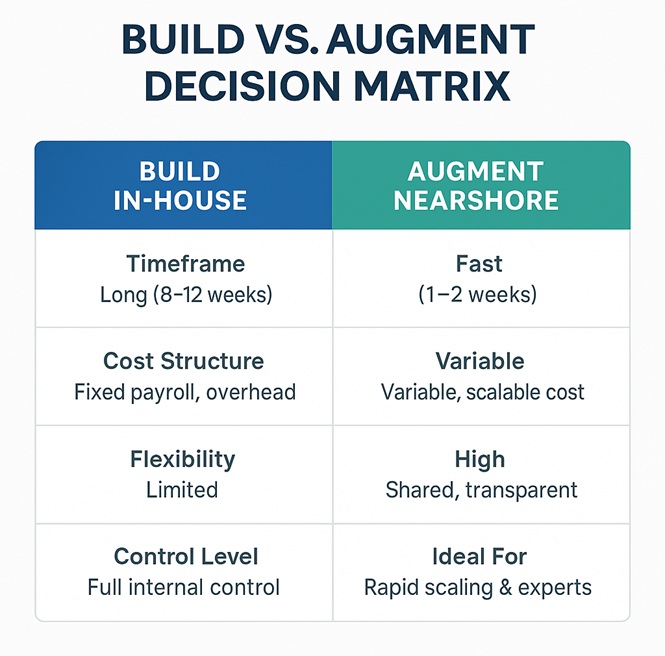
The takeaway:
Staff augmentation isn’t a replacement for internal hiring, it’s better to see it as an accelerator.
It complements your in-house expertise, allowing you to move faster, scale smarter, and deliver with confidence even under tight timelines.
8. Common Misconceptions (and Why They’re Wrong)
Despite its proven success, staff augmentation is often misunderstood.
Many companies associate it with traditional outsourcing or short-term contracting, when in reality, modern nearshore augmentation has evolved into a far more collaborative and strategic model.
Below are some of the most common misconceptions and the facts that set them straight.
Misconception 1: “It’s just outsourcing with another name.”
This is perhaps the most frequent misunderstanding.
Outsourcing typically transfers ownership of deliverables and management to an external vendor. You lose some control but gain a completed product.
Nearshore staff augmentation, on the other hand, is about team extension, which means you retain full control of your roadmap, tools, and standards, while leveraging nearshore talent to execute faster and better.
Your developers don’t work for an external team. They work with yours.
That’s why Near Coding integrates directly into our clients’ Agile workflows, ensuring complete transparency and shared accountability.
Result: Clients experience faster delivery while maintaining 100% visibility into code quality, sprint velocity, and resource utilization.
Misconception 2: “Developers need to be closely managed.”
That might be true in low-engagement outsourcing models, but not in nearshore augmentation, especially not with Costa Rican teams.
Costa Rican engineers are bilingual, self-sufficient, and highly proactive. They’ve worked with U.S. and European teams for years and understand Agile communication, documentation, and accountability.
In Near Coding’s model, every developer is vetted not only for technical skills but also for autonomy and ownership. This allows them to integrate seamlessly into client teams without excessive oversight or micromanagement.
Data point: Over 90% of Near Coding engineers score “above average” in independent assessments of problem-solving autonomy and collaboration readiness.
Misconception 3: “Hiring quickly means lowering standards.”
Speed is not the enemy of quality — lack of preparation is.
Because Near Coding maintains a continuous recruitment pipeline, all candidates are pre-screened long before a client request arrives. That means when a project starts, we’re not rushing; we’re selecting from a curated pool of already-qualified professionals.
This approach eliminates the tradeoff between speed and skill. You get the right person faster — not just the first available one.
Fact: The average technical match rate for Near Coding’s placements is over 85%, compared to an industry average of 62% (TechServe Alliance 2024 data).
Misconception 4: “It’s only for large enterprises.”
While big companies often lead adoption, small and mid-size businesses benefit just as much — sometimes even more.
Nearshore augmentation gives smaller teams access to enterprise-level talent and delivery capabilities without the cost or bureaucracy of traditional outsourcing contracts.
It enables startups and SMBs to launch products, expand features, or modernize systems with flexible commitments and predictable budgets.
Example: Several Near Coding clients started with 1–2 developers and scaled to full teams within months — keeping agility and personal collaboration intact.
Myths vs. Facts
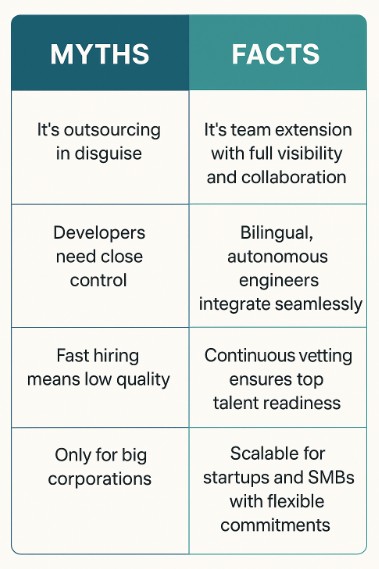
9. The Real ROI of Nearshore Staff Augmentation
The true value of nearshore staff augmentation goes far beyond reducing hiring timelines. When executed correctly, it delivers measurable returns in productivity, cost efficiency, and long-term scalability. Costa Rica, in particular, offers a unique blend of technical excellence, cultural compatibility, and operational stability that turns every project into a sustainable investment.
1. Faster Time to Market
Every week saved in software delivery has a measurable financial impact. Nearshore teams in Costa Rica operate in the same time zone as most U.S. cities, enabling real-time collaboration without delays caused by asynchronous communication.
For growing companies, this can translate into product launches up to 30% faster and feature delivery cycles shortened by several sprints. The result is earlier customer adoption and faster revenue generation.
Example: A U.S. Software Development company accelerated its roadmap by six weeks after onboarding Near Coding’s Costa Rican developers, allowing them to release a new module a full quarter ahead of competitors.
2. Lower Operational Costs Without Sacrificing Quality
Costa Rica offers one of the most cost-efficient labor markets in the Americas while maintaining strong quality standards. Salaries for senior software developers are 30 to 50 percent lower than in the U.S., yet the quality of work remains on par due to strong education, professional maturity, and bilingual fluency.
Beyond payroll, clients also save on:
Recruitment and onboarding costs
Equipment and workspace overhead
Employee benefits and tax liabilities
For most companies, these combined savings reduce total development expenses by 25 to 40 percent annually, depending on team size and structure.
3. Long-Term Team Stability
Costa Rica’s labor market has one of the lowest developer turnover rates in Latin America. The country’s professional culture values stability, continuous learning, and strong client relationships.
This translates into teams that stay longer, gain deeper product knowledge, and provide consistent velocity over time. Retention rates for Near Coding’s dedicated developers exceed 92 percent after the first year, significantly reducing the hidden costs of turnover and retraining.
4. Seamless Communication and Cultural Affinity
Proximity isn’t just geographic, it’s cultural. Costa Rican professionals share similar business ethics, communication styles, and work expectations with their U.S. counterparts. Meetings happen naturally during the same business hours, with no language or cultural barriers slowing down decision-making.
This creates a genuine sense of partnership rather than the distance often experienced in offshore models.
Insight: According to IDC Latin America, Costa Rica consistently ranks among the top 3 nearshore destinations for North American companies because of its cultural alignment and service quality.
5. Sustainable Growth and Strategic Advantage
Because Costa Rica’s technology ecosystem is built around renewable energy, education, and political stability, companies investing there are also building sustainable partnerships. The country’s 98 percent renewable energy matrix and strong governance frameworks provide a dependable environment for long-term collaboration.
When companies scale with Costa Rican nearshore teams, they are not only improving delivery performance, they are aligning with a region that supports resilience, innovation, and sustainable growth.
The ROI of Nearshore in Costa Rica
Here’s the conceptual layout of the ROI by using Nearshore in Costa Rica:
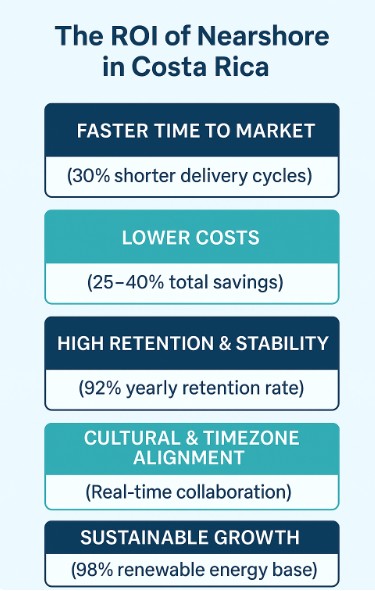
10. Conclusion: Build Fast, But Build Right
The ability to scale a software team quickly is no longer a competitive advantage. It is a requirement for any organization that wants to keep pace with today’s technology-driven markets. Yet, scaling fast only works when it is paired with structure, quality, and trust.
That is what Nearshore Staff Augmentation in Costa Rica provides: a balanced approach that allows companies to expand capacity rapidly while maintaining full technical and operational control.
Costa Rica has positioned itself as one of the most reliable and mature nearshore destinations for U.S. and international companies. Its proximity, time zone alignment, and bilingual workforce make collaboration seamless, while its political stability and educational strength ensure consistency and professionalism over the long term.
Through the 2-Week Scaling Blueprint, Near Coding has helped companies across industries (from fintech to telecommunications) assemble complete, high-performing teams in record time. These teams are not temporary contractors. They are integrated professionals who understand business goals, align with engineering best practices, and deliver results from day one.
The outcome is faster execution, stronger products, and reduced operational complexity. More importantly, it creates a bridge between your internal vision and external expertise, one that adapts to your growth rather than limiting it.
If your company needs to scale software delivery in weeks, not months, Costa Rica offers the perfect balance of speed, quality, and collaboration.
Partnering with the right nearshore provider is not just about filling roles. It is about accelerating success with the confidence that your extended team will work as naturally as your own.
That is the difference between simply hiring more people and building the right team, in the right place, at the right time.
If you are planning to scale your software delivery team and want to do it fast, consider Costa Rica as your next nearshore destination.
At Near Coding, we help U.S. and global companies build high-performing, bilingual development teams in as little as two weeks, fully integrated, agile, and ready to deliver from day one with our Nearshore Staff Augmentation approach.
Whether you need to accelerate a roadmap, strengthen your existing team, or start a new project, we can help you do it with the right people, the right process, and the right results.
👉 Talk to Near Coding today and discover how easy it can be to scale your team in Costa Rica.
Let's talk about your next project
Near Coding
Nearshore Software Services Partner
Service oriented, cost-effective, reliable and well-timed specialized in Software Development and located in Costa Rica
